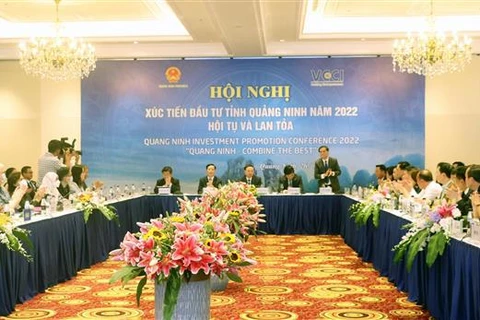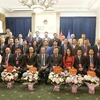 This year, the province has set a target of all districts earning the title of new-style rural area (Photo: moc.gov.vn)
This year, the province has set a target of all districts earning the title of new-style rural area (Photo: moc.gov.vn) Quang Ninh (VNA) – The northern province of Quang Ninh has rolled out a number of measures to complete its goal under the new-style rural area building programme for 2022.
This year, the province has set a target of all districts earning the title of new-style rural area, and having two out of seven districts in the province recognised as advanced new-style rural areas.
Quang Ninh also aims for 49 out of 98 communes, or 50%, becoming advanced new-style rural areas, and 25% of all communes recognised as model new-style rural areas.
To this end, the provincial Party Committee has requested districts and communes across the province mobilise the synergy of the whole political system and the responsible and active engagement of local residents in the implementation of the programme. This is especially so in criteria related to the environment such as sorting waste at source, ensuring environmental hygiene, and maintaining light, green, clean beautiful and safe residential areas.
Localities are asked to speed up the disbursement of the provincial budget for the building of new-style rural areas as well as capital for socio-economic development in mountainous, ethnic minority-inhabited, border and island areas. They were advised to make use of favourable weather conditions to speed up the progress of construction projects, especially infrastructure projects serving production, ensuring their progress and quality.
For transport projects, the localities were requested to ensure their long-term efficiency and its connections with urban areas.
At the same time, Quang Ninh will continue to develop new production and connections models, promoting the linkage between industry, service and agriculture and between sustainable rural development and urbanisation. Particularly, the province will pay greater attention to production models for households that have freshly escaped from poverty and those that live near the poverty line, thus avoiding relapse.
Meanwhile, the province will continue to concentrate on developing education-training and health care, while improving the infrastructure system.
In the first six months of this year, Quang Ninh saw good progress in the implementation of new-style rural area building programme thanks to the close coordination among local sectors and departments. The locality has reviewed the realisation of criteria for a new-style rural area, thus ensuring the completion of all criteria set for the 2021-2025 period.
Currently, Ha Long city and Van Don district have submitted their dossiers to seek recognition as new-style rural areas.
Under a decision on new-style rural areas for the 2021-2025 period, a new-style rural commune has to meet 19 criteria in many fields, including planning, socio-economic infrastructure, economy and production, socio-culture and environment. The criteria are specified for different regions.
Specifically, a new-style commune must have 80 percent of its farming area with active irrigation systems. In general, per capita income must be 48 million VND (2,100 USD) per year on the average in 2022. In particular, the per capita income is 39 million VND for northern mountainous and north central regions, while it is 53 million VND for the Red River Delta and Mekong Delta regions, and 63 million VND for the south eastern region.
The communes should have effectively operating cooperatives and production-selling connection models, implementing origin tracking regulations on their major products and developing farming areas meeting VietGAP standards.
At the same time, they must satisfy criteria on health care insurance coverage, the rate of malnutrition among children under five years old, and the rate of residents having electronic medical records.
They must show strong performance in environmental protection, especially waste treatment system, along with criteria on food safety.
Meanwhile, an advanced new-style rural commune must meet all criteria of a basic new-style rural area along with higher standards across all 19 criteria, according to the decision.
Particularly, the per capita income in an advanced new-style rural commune is 58 million VND per year on the average in 2022, and varies from 47 million VND to 76 million VND per year in different regions./.























